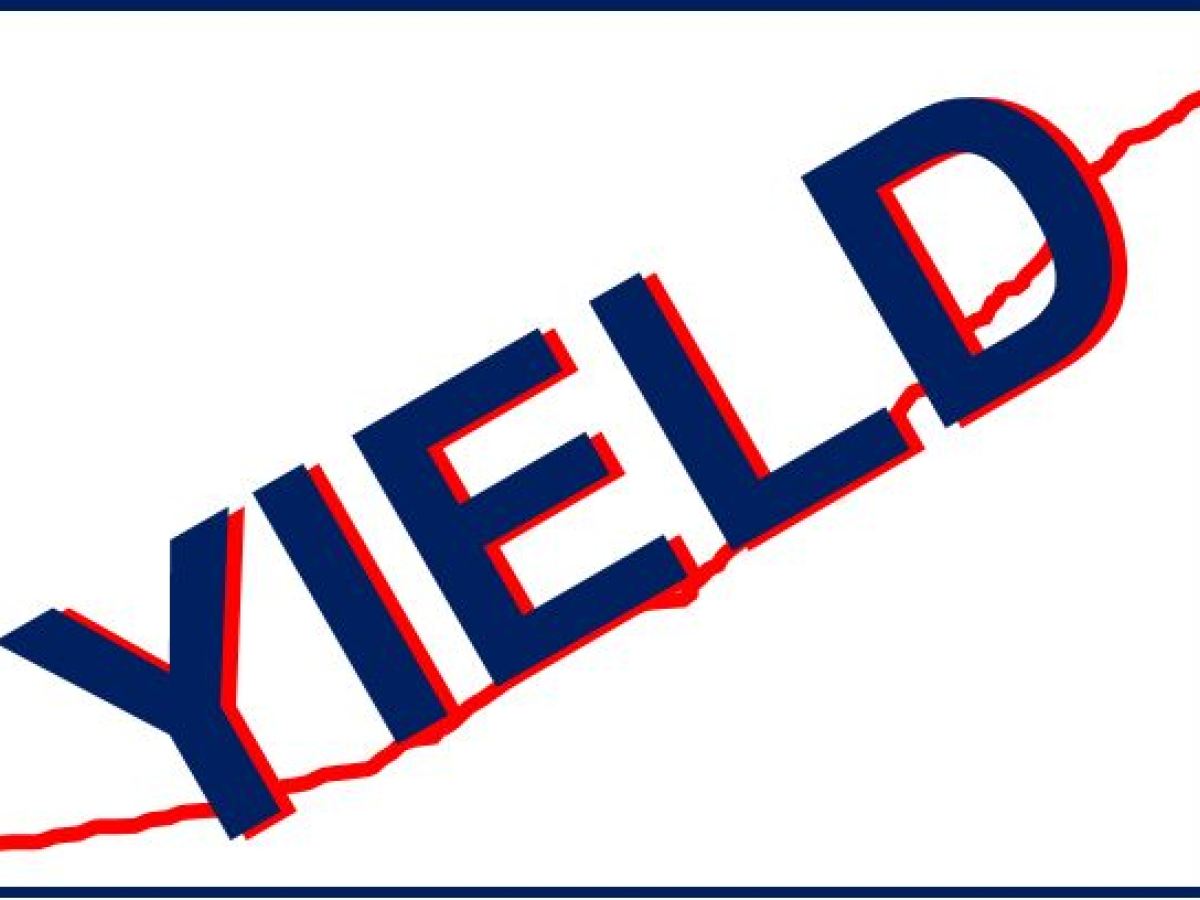Definition
Yield Meaning
Yield Fomula
Yield is a measure of the cash flow received by an investor on the amount invested in an investment. It is generally calculated on a yearly basis, though quarterly and monthly yields are occasionally employed. Total return, which is a more comprehensive measure of return on investment, should not be confused with yield. Yield is computed as follows:
Yield = Net Realized Return / Principal Amount
Gains and returns on stock investments, for example, might take two forms. First, it can be in terms of price increase, where an investor buys a stock at $100 per share and sells it at $120 after a year. Second, during the year, the stock may pay a dividend of, say, $2 per share. The yield is calculated by dividing the increase in share price plus any dividends paid by the original price of the stock. The example’s yield would be:
($20 + $2) / $100 = 0.22, or 22%
Importance of Return
What are the Types of Yield/Return
Returns can be classified according to the type of security and sometimes, some peculiar factors we’ll see shortly.
#1. Yield on Stocks
This is based on the type of security.
For investments in stock, two types of returns are popularly known.
- Cost yield: This is gotten when the return is calculated based on the purchase price.
Cost Yield = (Price Increase + Dividends Paid) / Purchase Price
- Current yield: To calculate the return here, you use the current market price.
Current Yield = (Price Increase + Dividend Paid) / Current Price
When a company’s stock price increases, the current return decreases because of the inverse relationship between yield and stock price.
Understanding Dividend stock and how to invest is a resource for you to read.
#2. Yield on Bonds
This is another type of return according to security.
There are bonds that pay annual interest. Their calculation is according to the nominal yield.
Nominal Yield = (Annual Interest Earned / Face Value of Bond)
For example, if there is a bond with a face value of $1,000 and maturity of one year and pays 5% annual interest. The return is $50 / $1,000 = 0.05 or 5%.
However, it is important to note that there are bonds with floating interest rates. Their returns change and are not steady over the life of the bond.
#3. Mutual Fund Yield
This represents the net income return of a mutual fund.
You calculate it by dividing the annual income paid by the value of a mutual fund’s shares.
It includes the income received through dividends and interest earned during the given year.
Since mutual fund valuation changes based on the daily net asset value, the mutual fund returns also vary with the fund’s daily market value.
#4. Yield to Maturity
Yield to maturity (YTM) is a particular measure of the annual total return on a bond if it is kept to maturity. It’s not to be confused with nominal yield, which is computed on a per-year basis and fluctuates with each passing year. YTM, on the other hand, is the predicted annual average yield, and the value is expected to remain constant throughout the holding term until the bond matures.
#5. Yield to Worst
The yield to worst (YTW) is a measure of the lowest possible yield on a bond that may be received without the issuer defaulting. YTW calculates the return that would be obtained if the issuer used provisions such as prepayments, callbacks, or sinking funds to calculate the worst-case scenario on the bond. This yield serves as a key risk indicator, ensuring that certain income requirements are met even in the worst-case situation.
#6. Yield to Call
The yield to call (YTC) is a measure associated with a callable bond—a type of bond that can be redeemed by the issuer before maturity—and refers to the bond’s yield at the call date. The bond’s interest payments, market price, and the length until the call date, which specifies the interest amount, all contribute to this value.
Meanwhile, municipal bonds, which are mainly non-taxable bonds issued by a state, municipality, or county to fund capital expenditures, also have a tax-equivalent yield (TEY). TEY is the pretax yield required for a taxable bond to have the same yield as a tax-free municipal bond, and it is determined by the investor’s tax bracket.
While there are tons of various ways to compute different types of yields, corporations, issuers, and fund managers have a lot of freedom to calculate, report, and market the yield value according to their own conventions.
But then regulators such as the Securities and Exchange Commission (SEC) have adopted a standard yield calculation known as the SEC yield. The SEC yield is a standard yield calculation produced by the SEC with the goal of providing a common metric for fairer bond fund comparisons. SEC yields are computed after the fund’s mandatory costs have been taken into account.
Read Also: How to Spot High Yield Investments (Easy Guide)
Yield Example
Consider an investor who wishes to calculate the yield to worst on a bond as one way to analyze risk. This essentially gauges the lowest possible yield. First, the investor would determine the bond’s earliest callable date, which is the day on which the issuer must return principal and cease interest payments. After calculating this date, the investor would calculate the bond’s worst-case yield. As a result, while the yield to worst represents the return over a shorter time period, it represents a lesser return than the yield to maturity.
How to Calculate Yield?
It measures the cash flow an investor receives on the amount invested.
Generally, yield = dividends or interest received in a set period of time / amount originally invested or current price.
For a bond, for example, if you invest $900 in a $1,000 bond that pays a 5% coupon rate, your interest income would be ($1,000 x 5%) = $50. The current yield will be ($50)/($900) = 5.56%.
High return either in stocks or bonds can be the result of a falling market value of the security.
For a stock, there are two kinds of yields: the yield on cost, and current yield.
Yield on Cost = Div/Purchase Price and Current Yield = Div/Current Price
If an investor puts $100 into a stock that paid $1 as an annual dividend. The yield on cost is $1/$100 = 0.01 = 1%.
If the investment made $10 during the year, and its current yield is $1/$110 = 0.009 = 0.91%.
From the examples, we can conclude that if the stock price increases and the dividend remain the same, the current yield will be lower than when the stock was originally bought. This is because yields have an inverse relationship with the stock price.
Read Also: Inverted Yield Curve: All you need to know with detailed analysis (+examples)
How to Evaluate Yield
Yield is one part of the total return of holding a security.
A higher return allows the owner to regain his investment amount sooner, and so reduces risk. On the other hand, this high return may have been a result of higher risk that has made the market value to fall.
Fears of high inflation in the future mean that investors ask for a high return on investment today.
The relationship between yields and maturity is described by the yield curve.
The more the risk, the higher the return since investors need a form of compensation for the risk.
What Is the Highest Yield Investment?
Because higher yields are frequently associated with more risk, a variety of high yield investments appeal to investors who are more risk-tolerant than risk-averse.
But then a couple of viable higher-yielding options according to reviews include, high yield bonds, Canadian Income Trusts, Master Limited Partnerships, Dividend Paying Stocks, Preferred Stocks, Real Estate Investment Trusts, and High Yield Bonds.
Yield is quite an interesting subject. Did we explain it to your satisfaction? Leave us a comment in the box below.
Yield FAQ’s
What yield really means?
In understanding the meaning of yield, one would have to know 3 basic things; Cost, return, and time. If Mr. A bought a share from company ABC at $10(cost) per share with a yearly(time)…
What is meant by yield in finance?
Yield in finance is the earnings made from an investment or security over a period of time.
How is yield calculated?
Generally, yield = dividends or interest received in a set period of time/amount originally invested or current price.






